<1>The term “scraps” had a great deal of resonance in popular print culture during the early and mid-Victorian periods. Cheap newspapers such as the Weekly Dispatch (1801–1928) and the London Journal (1845–1906) included miscellaneous columns with titles such as “Facts and Scraps” and “Varieties” in their back pages—compilations of original and reprinted snippets that were meant to be entertaining and informative rather than topical and timely. It was the stuff of leisure time reading: poetry, anecdotes, fun facts, humorous paragraphs, and scraps of domestic wisdom. In this sense, miscellaneous columns functioned as what Katie Day Good calls “media assemblages”: collections of choice extracts from diverse print sources (561). This idea of assemblage was also reflected in the titles of women’s periodicals founded in the 1830s, such the Bas Bleus Scrap Sheet (1833), Fisher’s Drawing Room Scrap-book (1832–54), and the Pocket Album and Literary Scrapbook (1832). Of course, the term “scraps” suggested ephemerality and unimportance—the kind of reading material designed to fill an idle hour. Yet, as we will see, these materials, through a process of selection, could be imbued with a personal and cultural value that belied their ephemeral source publications.
<2>The proliferation of scraps in family weeklies corresponded with the emergence of a scrapbooking fad in middle- and upper-class domestic life. In fact, the Oxford English Dictionary records the first use of the term “scrapbook” in 1825, just as popular print culture was opening up into its broad Victorian dimensions. Of course, commonplace books and friendship albums far predated the early nineteenth century. What was new about the scrapbook was its repurposing of the ephemera of popular print culture. In a scrapbook, an article on floral arrangement might be juxtaposed with a humorous poem or a paragraph about the vagaries of love—materials cut or copied from periodicals and arranged in a personally meaningful order. The selection and arrangement of scraps came to be associated with “feminine” domestic culture, serving as both a leisure activity and a creative outlet. Miscellaneous columns were likewise designed to appeal to female readers and often served as a major source of content for scrapbooking. The cheap weekly periodical, the miscellaneous column, and the scrapbook thus co-evolved as interdependent genres. (1)
<3>In the pages that follow, I examine scrapbooks held by John Rylands Library and the Harry Page Collection at Manchester Metropolitan University dated between 1825 and 1860. These albums have much to tell us about how middle- and upper-class women read: their processes of selecting, copying, arranging, and editing printed scraps in creative ways. Composing a scrapbook was an active, generative process that involved removing the temporal markers associated with popular print artifacts and altering their meanings through fresh and sometimes jarring juxtapositions. Victorian scrapbooks tell us not only how Victorian women read but also what they read—the poems they found resonant, the prose excerpts they found inspiring, the jokes they found amusing, and the images they found pleasing. Sometimes scrapbook creators cut and pasted these materials from newspapers and periodicals. In other instances, they hand-copied passages from their reading, thus following the conventions of a commonplace book. In either case, they embellished excerpts with calligraphy, borders, lace, etchings, newspaper images, or hand-drawn illustrations. As a leisure-time activity, scrapbooking was purposeful and artistic—an active process of creating meaning from the ephemera of daily life.
<4>The act of collecting and arranging scraps during leisure time at home was not only an expression of personal interest but also a means of displaying tasteful reading habits—a vehicle of self-representation that could be shared with others in the domestic circle.(2) The fact that many scrapbooks were anonymous serves as a reminder that the identities of their creators were understood by family and friends and thus did not have to be written down.(3) We can nevertheless infer, based on the domestic content of most scrapbooks, that they were often created by women. As Amy Mecklenburg-Faenger has shown, during the Victorian era the practice of scrapbooking was increasingly (and often derogatorily) defined as a feminized activity associated with domestic leisure time. The ubiquity of scrapbooks in the early to mid-Victorian period indicates that they were an important medium for women’s self-expression and self-fashioning; thus, they are an important source for understanding women’s everyday experiences as readers and artists. As Maria Damkjær notes, “Albums more than any other genre dramatize the aesthetic and affective possibilities of reception, and show print consumption to be dis-synchronous, imaginative, residual and irreverent” (148–49).
<5>In the first part of this essay, I explore some of the challenges that arise when reading women’s scrapbooks and then demonstrate methodologies that help us begin to unpack their meanings, especially their relationship to the popular press, which served both as a creative inspiration and a source of content. In the next section, I examine a type of content that was particularly ubiquitous in scrapbooks: poetry. The frequent appearance of verse in women’s albums corresponded with the proliferation of poetry in miscellaneous columns and other popular publication formats during the early and mid-Victorian periods. An investigation of how scrapbook creators sourced, selected, arranged, and embellished this material tells us a great deal about the function of poetry and poetic celebrity in women’s everyday lives. Finally, I examine a particularly remarkable scrapbook from mid-century that provides an enticing view of the broad range of periodicals and books middle-class women read—and how they used these disparate materials to imbue their leisure time with meaning.
Scrapbooks and the Press
<6>When scrapbook creators cut and pasted materials from newspapers and periodicals, they often removed the original publishing contexts. This might include the author, date, title, and other editorial features of the source publication and the placement of the excerpt on the page in relation to other periodical content. This process of de-contextualization suggests that it was the content of the scraps, rather than their status as original works of art, that made them personally meaningful. For example, most of the scraps in an anonymous scrapbook from John Rylands Library, dated ca. 1832, do not include authors, titles, or source publications (fig. 1). Thus, we can only surmise what meanings the scrapbook creator had in mind. The scraps on the page at first seem to have no relationship to each other. However, their meanings begin to come into focus when we locate the publications from which they were sourced. By searching the British Periodicals database, for example, I was able to trace the poem “The Stranger” to a review essay published in the Literary Guardian on June 23, 1832. I discovered the name of the author as well: Barry Cornwall (the pen name of Bryan Proctor, 1787–1874). There were of course many re-printings of the poem in various periodicals and newspapers. But the typographical peculiarities of the Guardian—its use of capital letters in the title and quotation marks around stanzas—made it possible for me to identify it as the likely publication source.
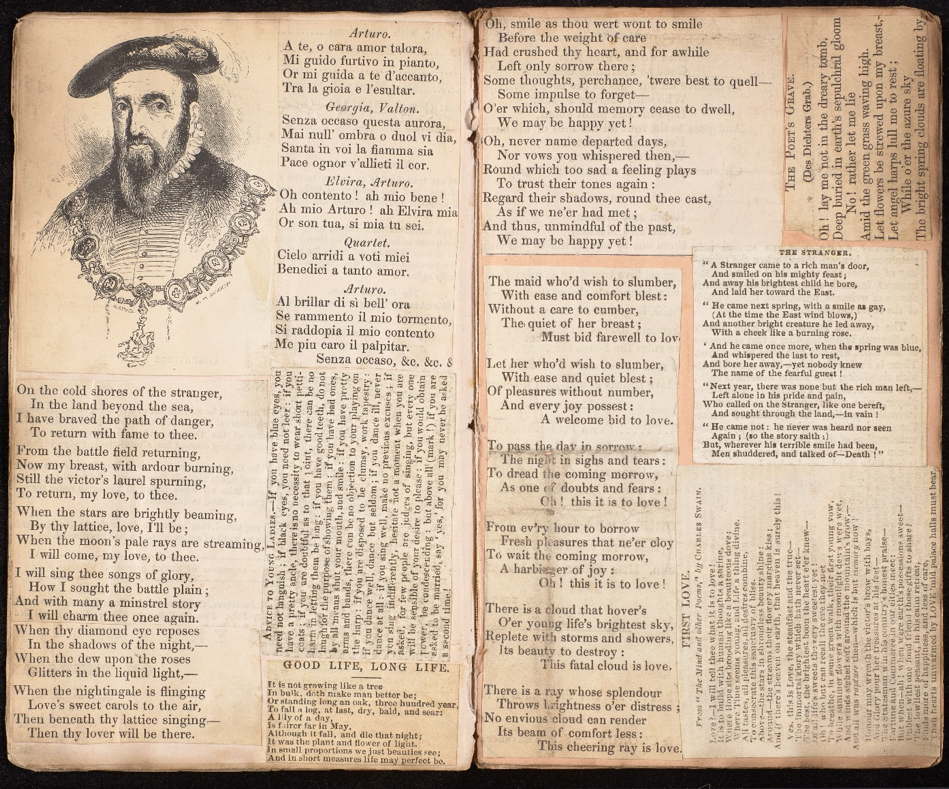
<7>On the other side of the scrapbook page is “On the Cold Shores of the Stranger,” which, a search of Google Books revealed, are song lyrics written by J. E. Carpenter (1813–85). The lyrics recount a soldier’s safe return home to his beloved after the war—a theme that resonates with Cornwall’s poem, which meditates on death, the “stranger” that takes those we love away. The soldier in Carpenter’s song has evaded, for now, the grim certainty of death described in Cornwall’s poem. Although I was able to identify Carpenter’s name through a search of Google Books, I was not able to locate its original source publication, most likely because it appeared in a newspaper that is not accessible in British Library Newspapers, the database I happen to have access to at my university. This database, of course, represents less than 1% of the British Library’s newspaper holdings. The source of the Carpenter piece thus most likely lies in what Patrick Leary calls the “offline penumbra” of materials that have not been digitized (82).
<8>As much as “The Stranger” and “On the Cold Shores of the Stranger” seem to have been juxtaposed in an intentional way, it is harder to find obvious connections between other scraps on the page, for example, “Advice to Young Ladies,” a humorous paragraph on female social conduct. What might the edges between such disparate materials signify? What might they tell us about popular reading practices in the 1830s? Did the scrapbook creator see resonances here or was she simply fitting snippets into available spaces? Of course, these questions are familiar to all of us who study Victorian periodicals. Because we lack the metacommentary behind the construction of most scrapbooks and periodicals, we must read them as we read literary texts—with attentiveness to both form and context.
<9>For most of the scrapbooks in the Harry Page Collection at Manchester Metropolitan University, we must take the interplay between press cuttings and images into account. The page shown in figure 2, for example, is from an anonymous scrapbook (ca. 1834) that includes snippets of humor, mostly derived from a miscellaneous column in the Morning Post titled “The Fashionable World.” One of these snippets, “On an Insipid Book with the Author’s Portrait in Front,” appeared in the Post on October 22, 1823. The text reads, “The disappointed Reader justly to console, / Who seeks in vain for beauty in the book, / Proving his body fairer than his soul, / The Author shows his face—behold his goodly look!” This and other scraps of humor are arranged in an artful way that draws attention to the central image of a man yawning, which further emphasizes the droll humor of the cuttings. The other images—of a castle, some medals, a manor house, and a group on a religious pilgrimage—are much harder to interpret in connection with the humorous anecdotes. They seem to have been placed simply to complete the composition, making it visually pleasing. Thus, this scrapbook, like so many other examples of the genre, oscillates between the construction of intentional meanings and the arrangement of visual delights based on color, shape, and composition.
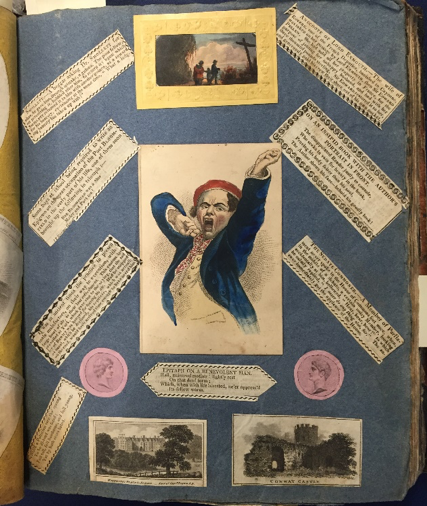
<10>Of particular interest are the borders around the snippets on this page—all of which were cut and pasted from another source. This sort of embellishment is designed to obscure the cut edges of the newspaper fragments, making them seem more pictorial. We can perhaps approach them as Elaine Freedgood interprets decorative fringe in Victorian interior decoration: as a kind of “kitsch” or excessive decoration which obscures and blurs the edges of things, “construct[ing] limits as variable, permeable, and attenuated structures” (257).(4) If the edges of newspaper scraps define them as paper ephemera, the addition of a decorative border is simultaneously an attempt to obscure the original publication context, to make the print object newly interesting, and to suggest the fungibility of borders imposed by print culture, which can be altered and repurposed for other kinds of artistic and domestic purposes.
<11>Other scrapbooks in the Harry Page Collection incorporate original drawings that serve as elaborate frames for press clippings. For example, a scrapbook created by Anne Wharton Stock (1836–72) incorporates a clipping of Gerald Massey’s poem “That Merry Merry May,” which was cut from a review essay published in the Times on August 24, 1854 (fig. 3). The source of the scrap can be determined by typographical detail and the careful trimming out of the prose content of the rest of the review. Massey’s poem celebrates the “olden Times … / When the world was in its golden Prime,” and Stock embellishes on this theme by creating an ornate pencil drawing as a frame that echoes the poem’s imagery. “Every vein of earth was dancing / With the spring’s new wine,” the poem reads, “‘Twas the pleasant time of flowers, / When I met you, love of mine!” The penciled-in frame enshrines the newspaper scrap yet oddly points to its status as a cheap, anonymous cutting from an ephemeral newspaper. Stock created this scrapbook page when she was about eighteen years old. Perhaps Massey’s meditation on spring love fit with what was expected of a young woman at the time or referenced biographical details from her life story that are now inaccessible to us.
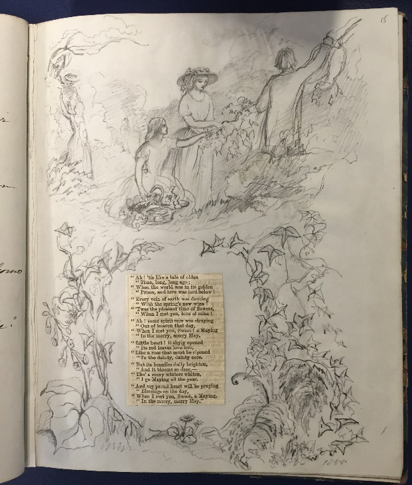
Scrapbooks and Periodical Poetry
<12>As Anne Wharton Stock’s scrapbook demonstrates, poetry was a particularly important form of content in women’s scrapbooks at mid-century. This was in part due to the ubiquity of verse in newspapers and periodicals—general-interest publications as well as those aimed specifically at women. As Kathryn Ledbetter points out, poetry frequently “appear[ed] in women’s periodicals of all types for all classes of readers to the end of the Victorian period, and it [was] displayed in an immense variety of textual formats, from elaborate artistic illustration, anecdotal references, poetry columns, quotations, epigraphs, and reviews, to brief stanzas at the end of a page or an issue” (3). In all of these contexts, poetry served as a vehicle for expressing the struggles, sentiments, and delights of everyday life. It was thus prime material for the scrapbook genre, which, as Ellen Gruber Garvey notes, functioned as an “index to the popular heart” (“Scissorizing” 214).
<13>In my own informal survey of scrapbooks in the Harry Page Collection, I discovered that of the 276 albums included in the collection, approximately 42 incorporated a substantial amount of poetry, either hand-copied verse or poems cut and pasted from periodicals and newspapers. Sometimes scrapbook creators collected literary scraps by famous writers as a form of celebrity worship; in other instances, they cut away authorial names, thereby suggesting that the sentiments expressed in the excerpts were more important than their cultural status. When authorial attributions were provided, I kept a running list of the names that most often appeared. The most frequently named poet was Henry Wadsworth Longfellow, followed by Felicia Hemans, Charles Swain, Letitia Landon, Lord Byron, and Robert Southey. Some thirty other writers were identified by name, ranging from popular authors such as Frances Browne and Adelaide Proctor to poet laureates Alfred Tennyson and William Wordsworth. The juxtaposition of poems by a wide variety of poets suggests that poetic celebrity, as constructed by middle-class readers, included male and female writers from all classes, those with wide popular appeal and those with elite, consecrated status.
<14>The fact that the vast majority of verse in scrapbooks appeared without titles or authorial attributions echoes the practices of scissors-and-paste journalism in popular periodicals and newspapers, which, due to ambiguities in copyright law, reprinted material from other papers in whatever form suited their needs. They might omit the author’s name, change the poem’s title, or simply cite the original publication source. When extracting poetry from the popular press, scrapbook creators therefore might not have access to the authors and titles of the verse they collected. Sometimes, however, they willfully suppressed this information by cutting away the author’s name or the poem’s title, perhaps because it would fit better on the page.
<15>A poem might also be selected for inclusion because it resonated with a theme such as “love,” “friendship,” or “hope” that the scrapbook creator had chosen as an implicit or explicit point of focus for an album page. For example, the two-page spread in figure 4, from an album in the Harry Page Collection, establishes its theme with a hand-colored plates of women in traditional clothing from the Caën and Bolbec regions of Normandy, images that originally appeared in Costumes des femmes du Pays de Caux by L. M. Lanté, published in 1827. This identifying information has been omitted, making the figures seem like lovely women clad in quaint attire rather than models of regional dress. Some of the accompanying cuttings seem randomly selected to fill the page (e.g., a paragraph on naval etiquette), but most include reflections on women’s outer and inner beauty, the “surface” represented by the fashion plate cutting and the depth it alludes to or conceals. One brief snippet of verse references external beauty:
‘Twas surely nothing strange to see
An epicure in sweets—a Bee
Rest on thy dimpled smile—
The role so tempting seem’d to blow,
And blended with such lilies too,
That Nature bid it rest awhile.
This passage was originally published in Barnard Trollope’s poetry collection Leisure Moments (1826). The passage compares female beauty to a flower, which is an irresistible, “natural” attraction. The scrapbook extends the metaphor by placing cutouts of insects on the opposing page, as if they are attracted to the superficial feminine beauty depicted in the plates. Another verse cutting, “Human Life,” tells the sad story of an heiress “lovely and bright” who is born, marries, and dies, serving as a reminder of the ephemerality of both beauty and life. The lily blooms but ultimately fades and expires.
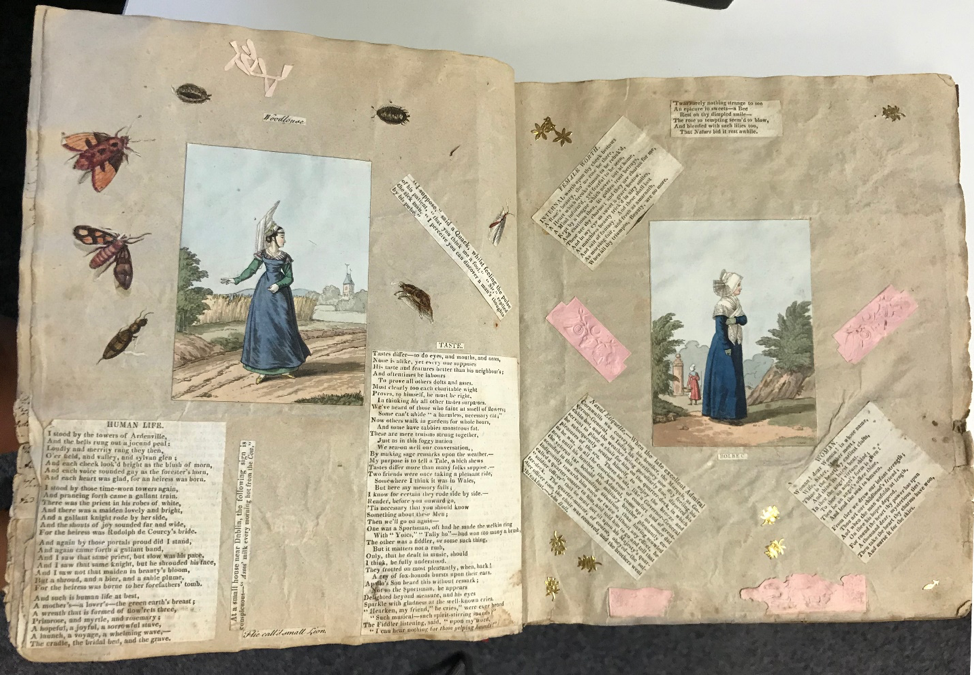
<16>Yet other cuttings on the page emphasize women’s immaterial virtues. A verse cutting titled “Female Worth” extols women’s “internal” merit, which “upon thy cheek bestows / A Rose’s beauty, tho’ no rose be there / … And these [virtues] shall last / As morning fair, and fresh as amaranth, / When all thy triumphs, Beauty, are no more.” This poem was most likely sourced from a September 15, 1825 issue of Berrow’s Worcester Journal, as is suggested by particularities in its typographical format. The poem in the lower-right-hand corner, “Woman,” is more difficult to trace to a specific publication though it was reprinted widely, for example in an October 1818 issue of the Provincial Magazine. It, like “Female Worth,” constructs a domestic paragon in whom “angel virtues shine.” Taken as a whole, the two-page spread suggests that woman is a thing of nature, both beautiful and ephemeral, yet she is also a site of transcendent meaning which belies this materiality and the superficial pictorial surfaces that claim to represent her. Clearly, the scrapbook creator was interested in these conflicting meanings of womanhood, which cause the reader to look at the colored plates with fresh eyes, interrogating their beautiful surfaces but also their deeper transcendent meanings.
Scrapbooks and Leisure Reading Practices: The Case of M. A. C.
<17>Thus far I have explored individual scrapbook pages as sources for understanding women’s reading and creative practices. Examining a scrapbook as whole provides a broader lens for surveying the diverse array of newspapers, books, and periodicals middle-class women read in their leisure time. It also enables us to consider how scrapbook pages work together to constitute a form of self-fashioning: a portrait of the scrapbook creator as a woman and artist. To conduct this broader-scale analysis, I chose an anonymous scrapbook from the Harry Page Collection at Manchester Metropolitan University known only as #144. This album is lengthy, comprising 182 pages filled with hand-copied passages from reading as well as hand-drawn and hand-cut borders, illustrations, and decorations.(5)
<18>The authorship of the album is ambiguous given that the cover is embossed with the initials W. M. W. while the title page and various other contents of the scrapbook refer to M. A. C. It is possible that the scrapbook was a hand-me-down from a relative or friend who decided not to take up the scrapbooking hobby—or perhaps that two individuals collaborated on a joint project. Yet the fact that most of the scrapbook is written in one style of handwriting suggests single authorship. Given that there is no name explicitly linked to the initials M. A. C., it is risky to infer the author’s sex. However, the content of the scrapbook—which often focuses on women’s concerns such as sewing, marriage, and gender roles—makes female authorship likely. The Catholic iconography incorporated throughout suggests the author’s religious affiliation, and its incorporation of French passages and images suggests her interest in life across the channel. Throughout there is a sense of playfulness. Alongside earnest and moralistic hand-written extracts, there are jokes, riddles, and humorous images from Punch and other satirical publications.
<19>What is particularly remarkable about M. A. C.’s scrapbook is its artistry—its vivid juxtapositions of hand-copied text and images from illustrated papers and other sources. The first page, for example, incorporates a trompe-l’oeil still life of a pencil, a lady’s portrait, and a cake of black paint—a juxtaposition that draws attention to scrapbooking as a meta-critical practice (fig. 5). M. A. C. depicts familiar objects and employs familiar modes of representation, while painting a portrait (or perhaps self-portrait) of ideal womanhood. The tools she uses to create the portrait—pencil and paint—are also those she uses to create the scrapbook itself. The accompanying quote, copied from Arthur Helps’s Friends in Council (1849), seems to introduce the album’s purpose: “The great deficiencies in criticism throughout all ages have been a deficiency of humanity, humility, a lack of charity, and a want of imagination.” In other words, its aim is to criticize criticism, bringing other virtues into play through a process of reprinting, rearranging, and reimagination. Either intentionally or accidentally, M. A. C. introduces a word into the quotation that did not appear in the original source: “humanity.” Such an interpolation sets the stage for the various ways she will alter found texts in order to express and visualize her own humanity as a reader and artist.
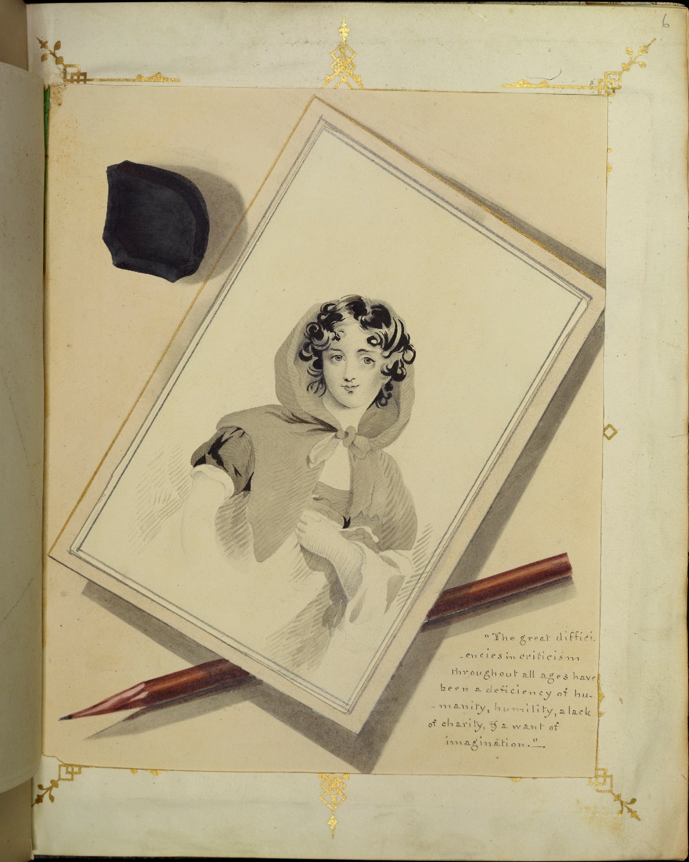
<20>When copying extracts from periodicals and newspapers, M. A. C. usually omits time stamps from the materials she has selected. Researching the original source of these materials helps to restore these missing temporal relationships. Maria Damkjær, in Time, Domesticity and Print Culture, analyzes scrapbook #144 as an example of how women creatively engaged with print culture to structure an alternate sense of domestic time (148–67). My analysis builds upon her study by investigating the range of material incorporated into the album, along with the probable print sources of this content. In order to provide a portrait of the scrapbook creator as reader, I listed each excerpt included in the album on a spreadsheet and did a key-phrase search of Google Books in order to identify (or at least approximate) the original publication sources.(6) This provided a compelling profile of what M. A. C. may have read.
<21>The title page of scrapbook #144 lists 1850 as its date of composition; thus, when I found a single quote in several sources in the Google Books archive, I chose the iteration that was closest to this time marker as the most likely source. Even though the scrapbook is dated 1850, most entries included in its pages can be dated from the mid-1840s to the late 1850s. This suggests that M. A. C. was making use of older materials lying about the house and that she integrated fresh material as it became available. Most of the traceable extracts in the album were selected from periodicals and newspapers published between 1847 and 1851 (70%). Other periodical excerpts, ranging from an 1810 article in the Lady’s Magazine to an 1836 essay in the New Monthly Belle Assemblée, seem to have been selected from periodicals of an earlier generation, perhaps those housed in bound volumes on a family bookshelf. Likewise, M. A. C. seemed to have access to a library of books (either in the home or via a lending library) dating from the late eighteenth century, including the Prose Epitome: Extracts (1792) and Introduction to the Art of Thinking (1789) by Henry Homes Kames. Book sources were less likely than periodical sources to be clustered in the period 1847–51 (27%). This is unsurprising given that books were viewed as being timeless and valuable and thus more likely to be preserved over time in a family library.
<22>When composing her scrapbook, M. A. C. generally did not proceed sequentially. Excerpts from older materials are not clustered in the early pages of the album; rather, they are juxtaposed with newer materials throughout. Theme, rather than topicality, seems to have guided her compositional approach. For example, one page features cupid on a chariot, signaling its thematic focus on love (fig. 6). The excerpts that follow are selected from diverse sources from a wide time frame, 1826–53. They also treat love in a divergent ways, ranging from humorous riddles to romantic effusions and moralistic reflections. An excerpt from Thomas Westwood’s 1850 poem “Love Her Still” implores readers to empathize with fallen women; a passage from Ann Radcliffe’s 1826 poem “On the Rondeau” highlights the agonies of romantic feeling; and a selection from an 1853 article in the Evergreen titled “Mothers and Daughters” argues for greater communication within families on the subject of courtship. After this final excerpt, a personal note is appended, “Amen! MAC says,” thus providing a rare glimpse of the scrapbook creator’s emotional reaction to what she read.
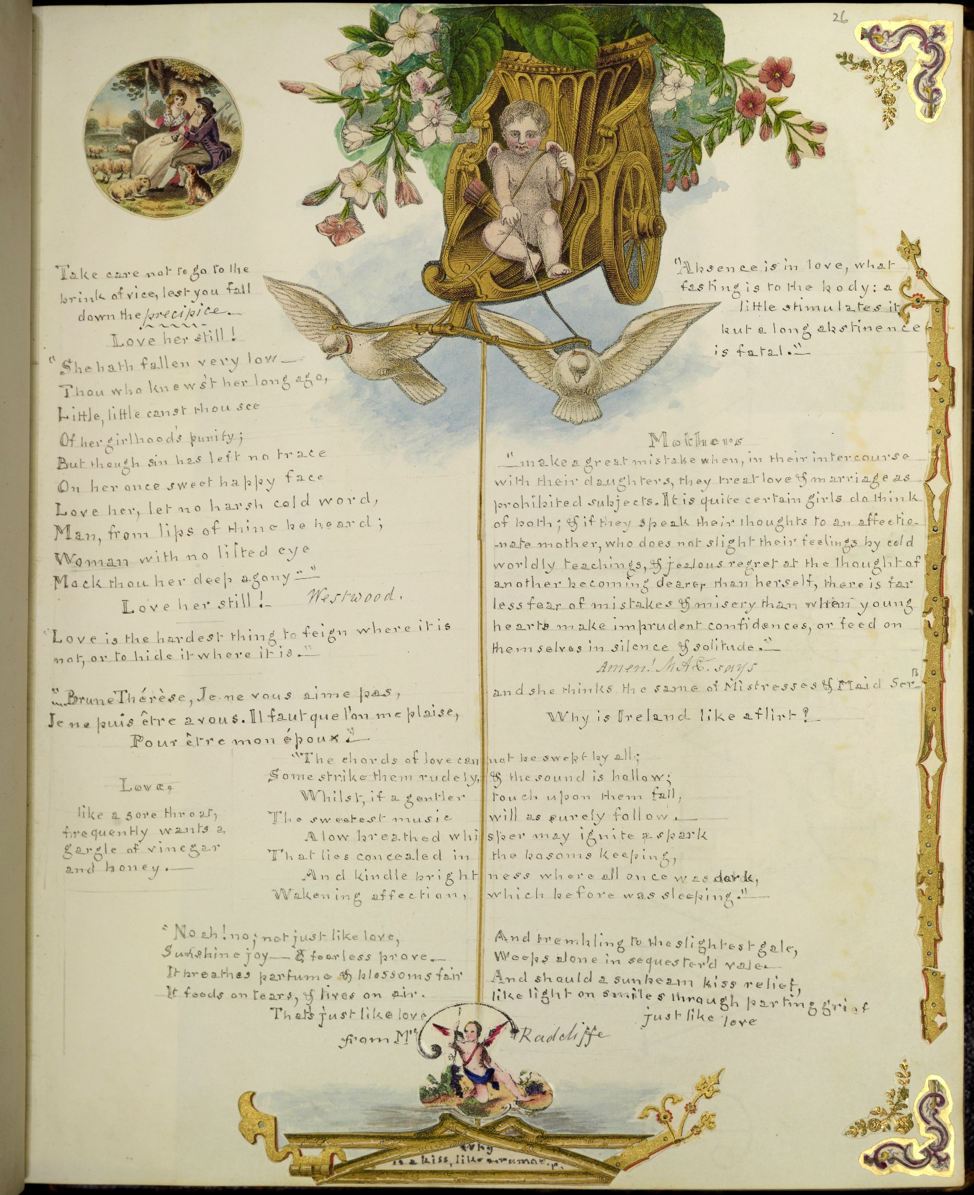
<23>Even though the arrangement of pages rarely seems sequential, a temporal series occasionally appears (fig. 7). On page twenty-eight, for example, five items in the right-hand column seem to have been copied down in sequence:
- “Independence,” a poem by Charles Swain from the November 13, 1847 issue of the London Journal;
- “Conscience,” a paragraph by “Dr. South” from the “Miscellaneous” column of the November 20, 1847 issue of the London Journal;
- “The Poor Man,” a poem by Charles Mackay published in the June 3, 1848 issue of the London Journal; and
- “Honest Man,” an aphorism from the “Diamond Dust” column of the January 12, 1850 issue of Eliza Cook’s Journal.
This sequence suggests that the scrapbook creator added items as they were published. We might surmise that the family subscribed to the London Journal and Eliza Cook’s Journal, which were affordable and addressed similar family audiences. However, such sequences are rare in M. A. C.’s scrapbook. More often, she seems to have selected materials from various time periods that she happened to have on hand.
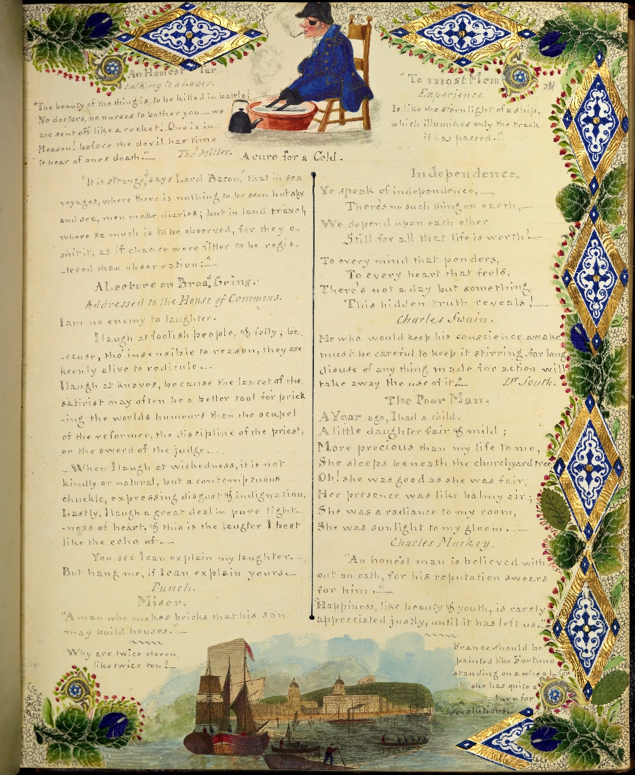
<24>Through the process of searching for key phrases from the album in Google Books, I was able to identify the probable sources of about 358 separate items in the scrapbook. The remaining 115 items did not match any sources in Google Books, suggesting that they were extracted from books and periodicals that have not yet been digitized. Analyzing the items I was able to identify as probable sources for the extracted material revealed some intriguing results. For example, about 84% of the excerpts copied into the album were prose, with the remaining 16% consisting primarily of verse. About 63% of excerpts with known sources were taken from periodicals, and 37% were extracted from book publications. While it may be risky to draw too many conclusions based on a single scrapbook, it is nevertheless fascinating to observe the important role newspapers and periodicals played in one woman’s leisure reading practices.(7)
<25>The extracts derived from periodicals are interesting to analyze from a quantitative perspective. The top five periodicals used as source material for the album were the London Journal (46 items), Household Words (14 items), the Family Herald (13 items), Punch (12 items), and Eliza Cook’s Journal (10 items). These weekly papers, all founded between 1841 and 1850, were aimed at general-interest readers who sought both information and entertainment at an affordable price (1–3d. per issue).(8) The London Journal and the Family Herald had circulations of 100,000 or higher in the late 1840s, while the others on the list achieved readerships in the 38,000 to 60,000 range. All played an important role in defining the new mass-market audiences that emerged with reductions in the taxes on print. When other cheap, general-interest periodicals such as Chambers’s Edinburgh Journal and the Family Friend are included in the count of often-sourced periodicals listed above, it becomes clear that family magazines constituted M. A. C.’s most frequent genre of source of material for the scrapbook (totaling some 153 items). The album thus confirms the vital interdependence of cheap family periodicals and scrapbooks as complementary media forms that arose with the expansion of print culture in the early to mid-Victorian periods.(9) Just as interesting as the list of periodicals M. A. C. used as sources for scrapbooking are the parts of these papers she found worthy of excerpting. She sourced many extracts from miscellaneous columns in weekly papers such as “Gems of Thought” (London Journal) and “Diamond Dust” (Eliza Cook’s Journal). The aphorisms, jokes, paragraphs, and quotable quotes incorporated into such columns were well suited to the scrapbooking activity, which relied on collectable tit-bits that could be paired with images, borders, and other decorations on the scrapbook page.
<26>When copying and arranging scraps in her album, M. A. C. often mimicked the double-column format of family periodicals (see, for example, figs. 6 and 7). She also occasionally included horizontal rules between items, as was sometimes the practice in miscellaneous columns (see fig. 6). Like the popular periodicals she used as source material, M. A. C. often printed extracts anonymously. In fact, she only included authorial attributions with 26% of the materials she included in the album. This was even true when she was extracting from novels or other books where the author’s name was clearly indicated on the title page. When she did include authorial attributions, she often changed her handwriting to approximate italic print, a typographical format sometimes employed in periodicals to distinguish text from a named source (see fig. 7).
<27>At the same time that M. A. C. mimicked periodical formats, she also took clear advantage of the haptic possibilities of the scrapbook genre (10). On one remarkable page, she chooses “Needles” as her theme (fig. 8). She not only incorporates a three-dimensional needle package but historicizes needlework as a domestic practice by quoting from an article on the needle-making industry published in a February 28, 1852 issue of Household Words. This anonymous article, written by Harriet Martineau, provides a detailed description of the manufacture of needles at a factory in Redditch, Worcestershire. M. A. C. quotes from the historical section of the article, but she must also have read Martineau’s description of how modern needles were created and the role women and children played in the manufacturing process. Martineau notes that the workers have an adequate education due to a well-funded local Sunday school (546). The household labor of needlework is thus revealed to be linked to the industrial and educational structures in which the needles are produced. The needle package thus serves as a reminder of the interconnectedness of women’s labor and education, both inside and outside the home.
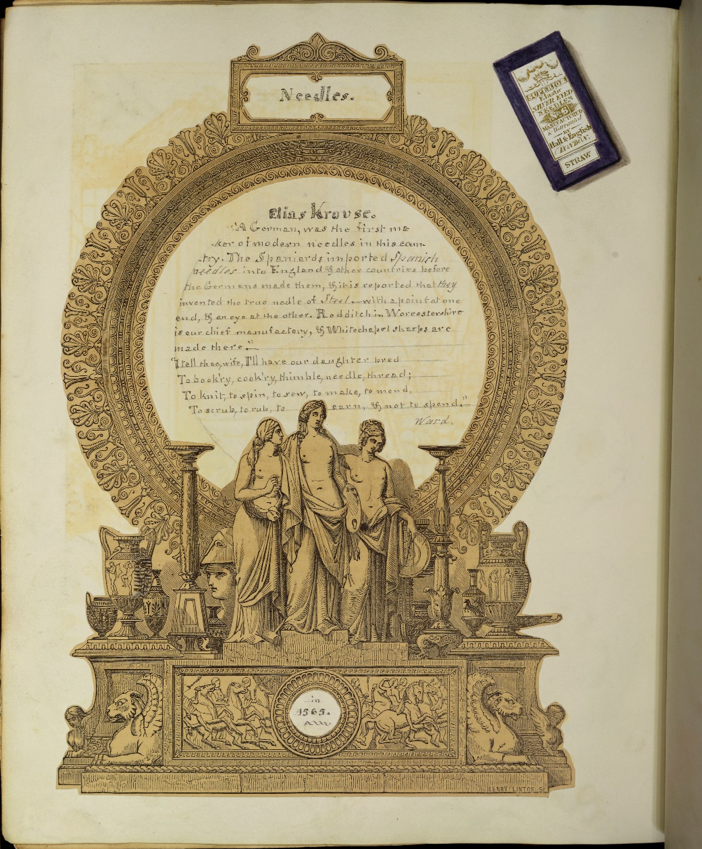
<28>The passage from Household Words links interestingly to another excerpt on the page from a poem by eighteenth-century writer Ned Ward, who references needlework as an essential skill for well-trained young women. The passage was most likely sourced from Caroline Norton’s 1851 novel Stuart of Dunleath, which incorporates the poem into a narratorial aside on the importance of practical education for the laboring classes. This echoes Martineau’s article, which praises the high-quality Sunday schools in Redditch. Yet these reflections on practical education—and the material histories informing everyday domestic labor—seem to stand in stark contrast to the image that frames them: an illustration of the three muses of drama, art, and astronomy. This image alludes to forms of classical learning and to women’s higher vocations as thinkers and muses. Sewing is a practical form of gendered work associated with domestic life that is enabled by working-class labor, yet it is also a metaphor for the scrapbook’s artistry, the piecing together of disparate, seemingly contradictory materials in creative, original ways (11). As Damkjær notes, the artful arrangement of the scrapbook page demonstrates “considerable expenditure of time on creative practices with very little household purpose” (150). Thus, M. A. C.’s own leisure at first seems to stand in stark contrast to the forms of labor the passages on the page allude to and describe.
<29>Yet elsewhere in the album she alludes to the significance of middle-class women’s leisure pastimes as a form of valuable domestic labor. One page, for example, includes a miniature cross-stitch sampler identified simply as “Caroline Gibson’s work” (fig. 9). It was perhaps a gift M. A. C. had received from a friend. Above the sampler, at the top of the page, is an image of a lovely girl in medieval garb, and the accompanying passages emphasize the feminine ideal. However, above and to the left of the sampler is a passage from a June 10, 1848 edition of the Family Herald that emphasizes female industry: “The poorest of all family goods are indolent females. If a wife knows nothing beyond the parlour or the boudoir, and is negligent or ignorant in her domestic duties; she is a dangerous partner in times of pecuniary uncertainty.” M. A. C. alters the passage from the Family Herald when copying it into her album, italicizing “indolent” and adding a second iteration of the word “duties”—alterations that emphasize the difference between idle and industrious femininity. She also inserts the words “negligent” and “ignorant” into the original passage, further underscoring the dangers of indolence.(12) A woman is a source of goodness but also a type of marketable “good” whose industry can be put to use in support of the family. Caroline Gibson’s leisure-time hobby is artistic but it also demonstrates a skill that could potentially be repurposed to commercial needlework in a time of economic distress. By extension, the scrapbook itself represents both an artistic accomplishment and industrious practice that is purposeful rather than indolent.
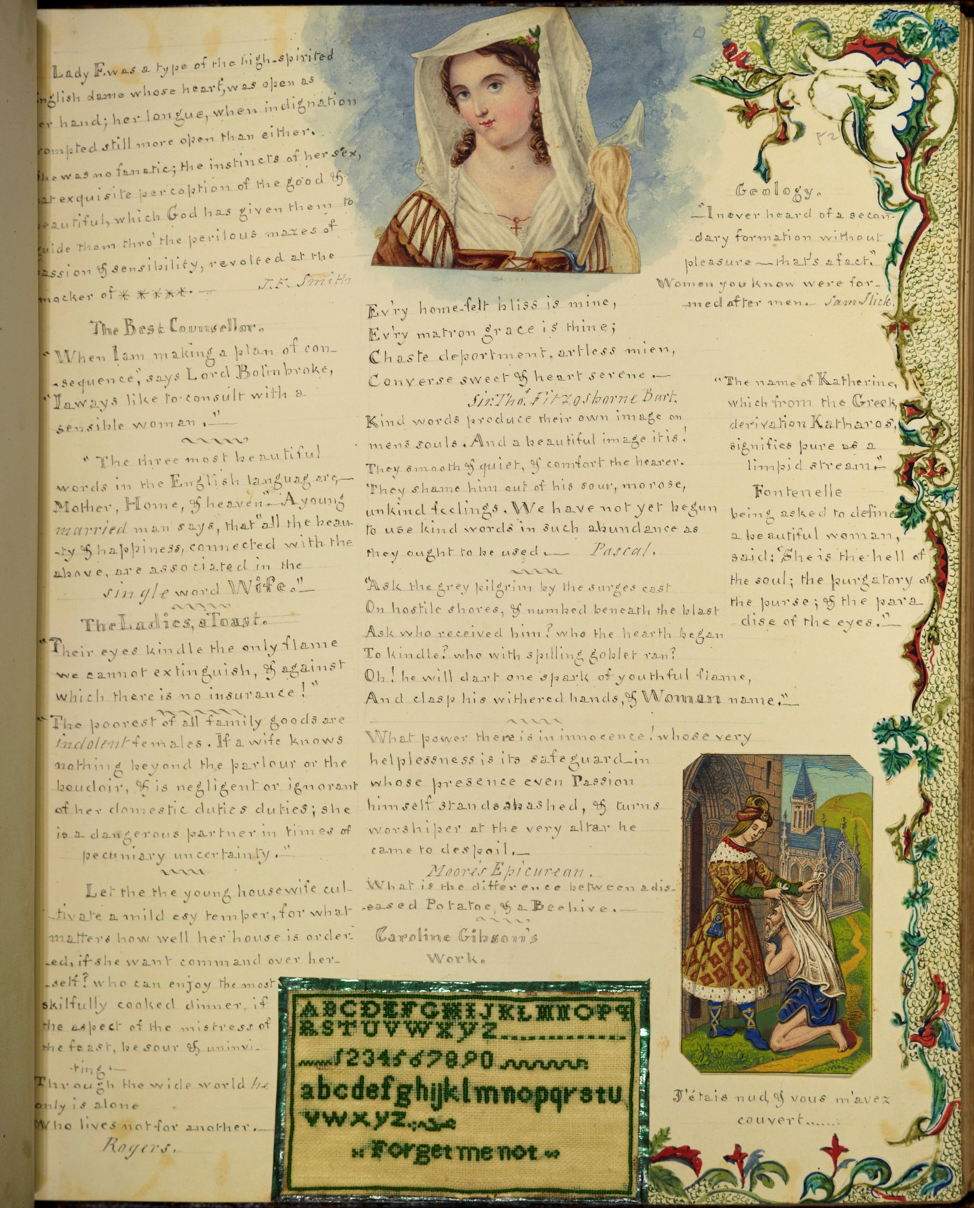
<30>Although periodicals were M. A. C.’s main source of material for the scrapbook, she also seems to have had access to a wide array of non-fiction books, including memoirs, sermons, letters, essays, and travel guides (41 items). In addition, she sourced material from popular anthologies (31 items) such as Charles Savage’s Illustrated Biography (1853), as well as from books of jokes and puns, along with popular literary collections such as Charles Knight’s Half Hours with the Best Authors (1847) and Chambers’s Cyclopedia of English Literature (1853). She also incorporated excerpts from a wide range of conduct manuals and Christian guidebooks (17 items) such as Maxims, Morals, and Golden Rules (1844) or the Illustrated Family Christian Almanac (1850)—the kind of books young women received as school prizes or as Christmas gifts from well-meaning relatives.
<31>M. A. C. also sourced material from novels, including works by Walter Scott, Charles Lever, and Edward Bulwer-Lytton. Interestingly, she not only excerpted prose passages but also the epigraphs included as chapter headings. For example, when reading Edward Bulwer-Lytton’s 1829 novel The Disowned, she was apparently struck by the epigraph to chapter 1, “I’ll tell you a story if you please to attend,” which the novelist had sourced from an 1812 poem titled “Limbo” by working-class writer George Knight. Consequently, just as M. A. C. frequently extracted material from miscellaneous columns that were often made up of extracts from other popular periodicals, she did not distinguish between original and reprinted material when reading novels, consuming prose excerpts as she encountered them—as quotable quotes reprinted as de-contextualized parts.
<32>When quoting from chapters of novels, rather than their epigraphs, M. A. C.’s selections provide tantalizing insight into how everyday readers consumed the works we now consider canonical.(13) On one page, for example, she quotes from Dickens’s David Copperfield, which was published in 1850, the same year she began her scrapbook (fig. 10). The quote appears on a page titled “Des Gens Célèbres,” which features quotes and impressions from famous writers, largely selected from literary reviews published in the Examiner. This includes items copied from January 4, 1851 reviews of Lord Holland’s Foreign Reminiscences and Alaric Watts’s Lyrics of the Heart. In these excerpts, authors are often depicted in direct or indirect “overheard” conversation with each other—for example, Hannah More advising Horace Walpole on how to punish an enemy (by “fastening on him the trouble of hating somebody”). In this regard, the quote from David Copperfield, which features Dickens’s description of the “abrupt, angular, extravagant” Betsy Trotwood, at first seems rather anomalous. Yet by situating the quote on a page of celebrity anecdotes, M. A. C. cleverly reimagines Charles Dickens and his literary creation as co-celebrities. His greatest achievement, she suggests, is his ability to bring characters fully to life so that they, too, achieve fame.
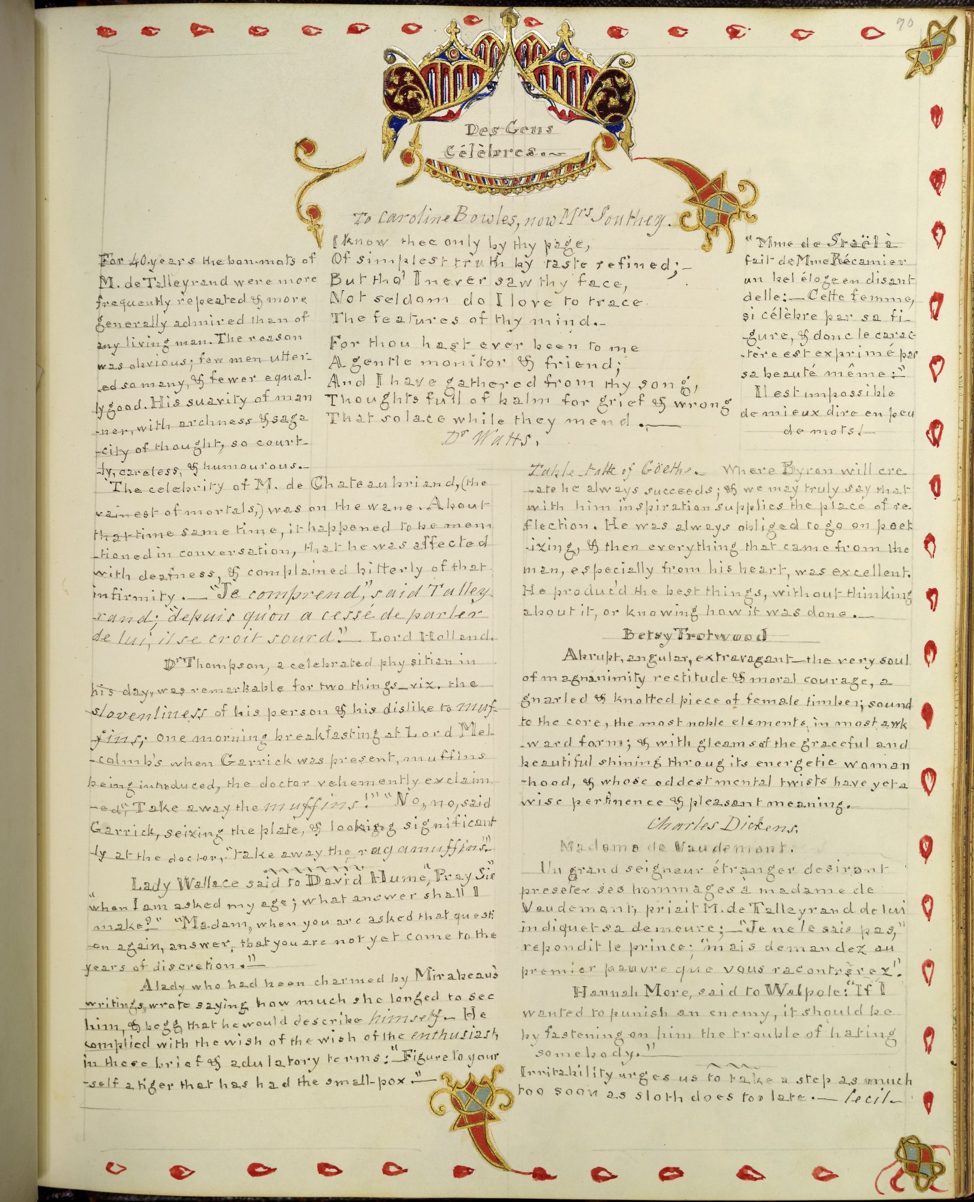
<33>In addition to quoting works of fiction and nonfiction prose, M. A. C. also copies passages from books of poetry (15 items). As was the case with most other scrapbook creators of the period, M. A. C. is catholic in her tastes, quoting from books by Thomas Hood, Alaric Watts, and William Cooper but also from individual poems published in popular anthologies such as Christmas with the Poets (1852) and J. W. Hanson’s Offering to Beauty (1853). The most curious poetic extract in the album is from an advertisement for Robinson Tea and Coffee Merchants, which may have been sourced from Bradshaw’s Illustrated Guide to Manchester (1857).(14) M. A. C. excerpts portions of advertising jingle: “This beautiful tea / Is valued by me, / It serves me—preserves me, / When winking, and blinking, / Or sinking or thinking” (fig. 11). The tone of this humorous rhyme is echoed in a juxtaposed passage from Anne March Caldwell’s 1844 novel Triumphs of Time, which effuses on “little China cups! as transparent as silver-paper and almost as thin, with rich red and brown pattern!” These lighthearted references to familiar domestic objects and the commodity culture associated with tea drinking link interestingly to other passages on the page—a “Hindoo” saying and an anecdote about Chinese tear bottles which were sourced from miscellaneous columns in Reynolds’s Miscellany and the Family Herald, respectively. The two other quotations come from a more somber source: China: Political, Commercial, and Social, a government-sponsored study by R. Montgomery Martin (1847). The excerpts from this report are framed by images of tea leaves and stereotyped Chinese men and women, which lightens the tone. Yet the overall effect of the page is to define tea drinking as a practice that links British commercial commodities to a colonized “Oriental” cultures abroad. The advertising jingle provokes laughter but also resonates with diverse materials focused on the culture and commodities of the East and their uses in a British imperial context.
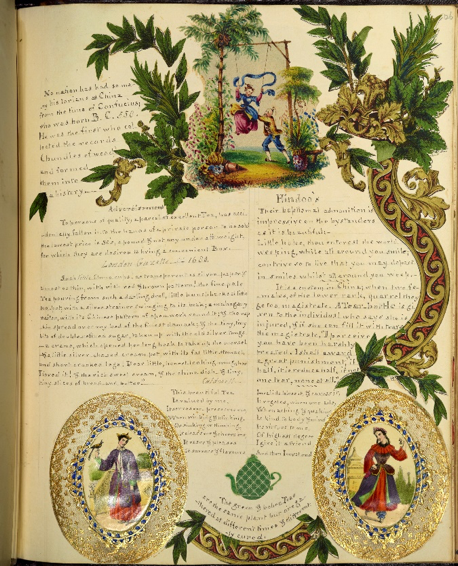
<34>M. A. C. did not always copy material verbatim from her reading; like sub-editors for cheap newspapers, she abridged and retitled material as she saw fit, thereby fashioning her collection of miscellanies to her own liking. For example, on one page she extracts a passage from Caroline Norton’s poem “Presentation at Court” published in the 1848 People’s Gallery of Engravings (fig. 12). She not only changes Norton’s title to “Part of a Letter from Miss Leticia to Miss Fanny of Clare Northumberland,” which closely matches the title of a different poem in the book collection, but she also omits two lines from the original poem. She embellishes the page with hand-cut medallions and an image of a peacock, which is perhaps meant to echo Norton’s spoof of the gushing Miss Leticia, who is clearly proud as a peacock as she describes the spectacle of being presented at court. On a facing page, M. A. C. incorporates the image that had originally accompanied Norton’s poem in the People’s Gallery, but she adds a date, 1850, which reflects the time it was sourced for scrapbooking rather than the time of its appearance in print. She thus locates the image within her own temporal frame of reference.
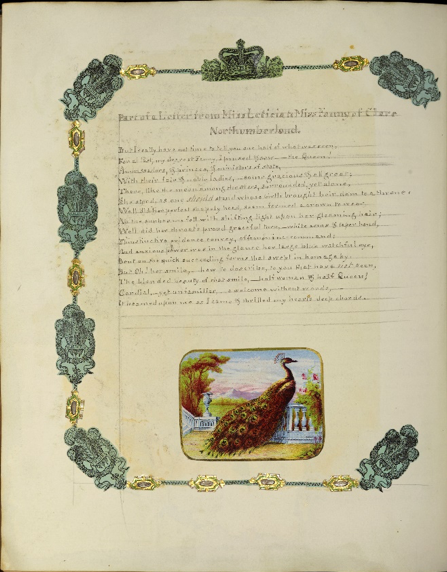
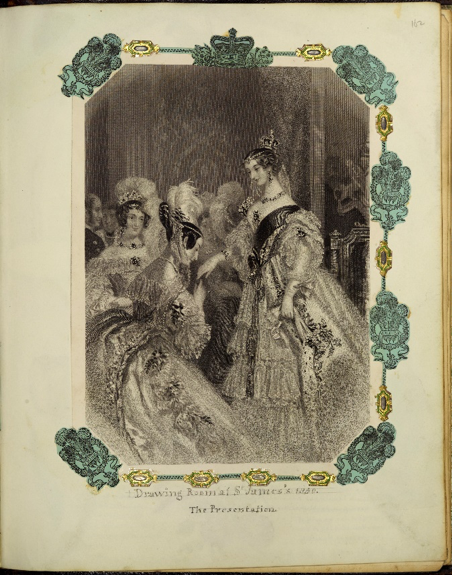
<35>In the People’s Gallery, the “Presentation at St. James’s” illustration originally appeared before Norton’s poem and was inserted awkwardly in the middle of a short, unrelated prose piece, “Ali’s Tent at the Camp of Benown.” M. A. C. improves upon this arrangement by removing the original format and adding embellishments mirroring those on the facing page, which together function as a unifying frame drawing attention to the complementarity between image and text. In making these and myriad other alterations in the scrapbook, M. A. C. enacts what Michel de Certeau calls “textual poaching.” Rather than passively consuming the reading material she encounters, she creatively rearranges and repurposes it in order to create emphasis, heighten satire, and assert her own aesthetic. As de Certeau points out, consumers of print media aren’t “fools”: they are “alternately captivated, … playful, protesting, fugitive,” wandering through “lands belonging to someone else, like nomads poaching their way across fields they did not write” (176, 175, 174).(15)
<36>M. A. C. not only provides a vivid demonstration of her own active reading and poaching practices but also playfully engages her own domestic readers by encouraging interactivity. On one page, for example, she inserts a window that her readers are invited to open, presumably to discover a secret or surprise (fig. 13). Instead of providing an obvious reward for their curiosity, she offers a puzzle of seemingly unrelated references. The image inside the window of young ladies bathing seems disconnected from the content on the facing leaf. First there is “Melanie,” which may have been M. A. C.’s first name. Next is a brief excerpt (with accompanying translation in a footnote) from Eliza Parker’s 1832 novel, La Coquetterie, which incorporates a quotation from poet Pietro Metastasio: “The faith of lovers is like the phoenix in Arabia; all will tell you it exists, but where no one can say.” Readers are left wondering whether she means to allude to the message of the poem or to the novel in which it is embedded. And how does this connect to the image of the bathers or to “Melanie” as a lover or an object of desire? Even more puzzling are the advertising slogans that follow: Horticultural & Floral Society / Incorrodible Artificial Teeth / A Variety of Spectacles / the Cambrian Infant Harpist. The first three slogans refer to advertisements in newspapers of the period, and the final slogan refers to Joseph Tudor Hughes (1827–41), a child prodigy who toured Great Britain and the United States in the late 1830s. It is possible that M. A. C.’s domestic readers would have been able to connect the dots between these disparate materials; however, it is just as likely that she was presenting them with a riddle they were challenged to solve through active reading and pop-culture association. The window, as a page within a page, draws attention in a meta-critical way to the act of looking (and the incitement to look) that governs the scrapbook as a whole. Both tease readers by re-contextualizing familiar materials (adverts, objects, images, epigraphs, and literary references) in jarring, complex, and humorous ways. Unpacking these meanings is to some degree more challenging for twentieth-century readers, who puzzle over pop-culture references that most likely would have been commonplaces to readers of the 1850s. Yet because we have access to digital archives such as Google Books, we can trace these references through a wide swath of print culture, making connections contemporary readers might have missed.
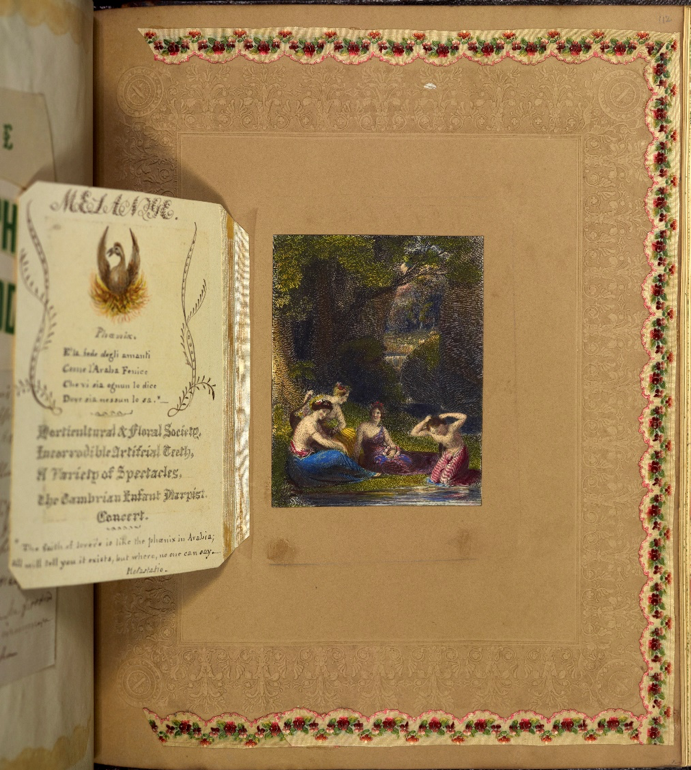
Coda
<37>It has always been something of a struggle to identify just what and how Victorian women read. Kate Flint, in her study of nineteenth-century women’s reading practices, emphasizes the “extreme heterogeneity of readers and their texts throughout the period” (187). Scrapbooks, as unique artistic objects, are perhaps more useful as case studies than as sources for developing a broad understanding of women’s leisure reading practices during the nineteenth century. They nevertheless provide a compelling record of what individual women read—the poems, images, and prose excerpts they found amusing, beautiful, or personally significant. In cases where we can restore the temporal markers and contexts omitted from scrapbooks, we can view these reading practices in an even sharper focus—identifying what particular books and periodicals women read and what parts of these texts they used as source material. Of course, such identifications are often speculative. As Maria Damkjær notes, scrapbooks are “inherently and unapologetically self-referential,” thus frustrating our efforts at piecing together coherent meanings and temporal frames (161).
<38>Yet even in cases where the identification of source material is doubtful—when a scrap turns out to be multiple, appearing as a “gem” in multiple Victorian newspapers and book sources—scrapbooks serve as an important reminder of the expansive and often redundant world of print that women readers encountered in their daily lives. They remind us that women not only encountered this abundance but also participated in the processes of reuse and remediation that prevailed within broader print culture. As Ellen Gruber Garvey notes, “Scrapbook making not only created a record of reception but contributes to our understanding of readers’ roles in recirculating both the items they read and their own readings or interpretations of those items” (“Power” 212; her emphasis).(16) When women pasted or copied “gems” from their reading into scrapbooks, they were participating in a process of remediation that was the hallmark of an emergent mass-media culture. In this sense, scrapbooking was an expression of modernity, what Clare Pettitt calls a “new age of the fast circulation and mobility of print” (33).
<39>Technological advancements in printing and distribution, along with reductions in the taxes on print, created the cheap weekly periodical, the printed scrap, and the scrapbook as interdependent forms of new media that in turn produced the mass-market woman reader and provided her with fresh outlets of creative expression. Scrapbook creators reinforced the divide between copies and originals by sometimes drawing attention to source texts as points of origin. Yet they also called this division into question by suppressing the authors, titles, and temporal markers of their source material and creatively manipulating these found materials through embellishment, misquotation, misattribution, decoration, juxtaposition, and other “poaching” strategies. In this way, they problematized the distinction between copying and creating, reading and authorship.
<40>Studying scrapbooks reminds us that the history of remediation far predates our present moment. Just as the scrapbook and the cheap newspaper arose as complementary new media in the early Victorian period, so, too, have the digital scrapbook and the digital archive co-evolved as complementary new media in our own time. The increasing accessibility of scrapbooks in digital archives has corresponded with the expansion of digital repositories such as Google Books and British Periodicals, which enable us to trace sources through key-phrase searching, thereby restoring the contexts of at least some of the scraps women chose to preserve. Yet to study scrapbooks and complementary media via digital editions is to be continually reminded of the gap between the material and the digital as well as between the texts we can access and those that have not been digitized. Our current digital research methodologies likewise prompt us to consider how the process of digital remediation creates new editions that rely on source texts but re-appropriate and manipulate this material in fresh ways. As Patrizia Di Bello notes, the haptic aspects of scrapbooks are lost through the process of digitization (158–60). The same can be said of digitized books and periodicals, which lack the material specificities of their originals: weight, color, smell, size, and texture. However, as Jim Mussell points out, to characterize digital editions as inferior copies of their originals overlooks the fact that that the “originals” are themselves always incomplete, offering only a “partial representation of nineteenth-century print culture” (204). And digital editions have a distinct advantage that their “originals” lack—searchability. It is this functionality that makes them eminently useful to our own creative engagements with material and digital scraps. If, as Geoffrey Pingree and Lisa Gitelman suggest, “we forget what older media meant, because we forget how they meant,” then the study of scrapbooks has a great deal to teach us about searching, reading, and remediation as creative processes, both past and present (xiv).
